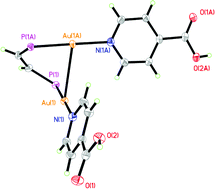Isolation of cationic digold-frame with free carboxylic acid pendants†
Abstract
Use of different diphosphines enables the isolation and crystallographic characterization of gold pyridylcarboxylate complexes with different structural motifs. Dppm [

* Corresponding authors
a NUS Graduate School of Integrative Sciences and Engineering, National University of Singapore, Singapore
b
Department of Chemistry, National University of Singapore, 3 Science Drive 3, Singapore
E-mail:
andyhor@nus.edu.sg
Fax: 65 68731324
Use of different diphosphines enables the isolation and crystallographic characterization of gold pyridylcarboxylate complexes with different structural motifs. Dppm [

 Please wait while we load your content...
Something went wrong. Try again?
Please wait while we load your content...
Something went wrong. Try again?
P. Teo, J. Wang, L. L. Koh and T. S. A. Hor, Dalton Trans., 2009, 5009 DOI: 10.1039/B823028E
To request permission to reproduce material from this article, please go to the Copyright Clearance Center request page.
If you are an author contributing to an RSC publication, you do not need to request permission provided correct acknowledgement is given.
If you are the author of this article, you do not need to request permission to reproduce figures and diagrams provided correct acknowledgement is given. If you want to reproduce the whole article in a third-party publication (excluding your thesis/dissertation for which permission is not required) please go to the Copyright Clearance Center request page.
Read more about how to correctly acknowledge RSC content.
 Fetching data from CrossRef.
Fetching data from CrossRef.
This may take some time to load.
Loading related content
